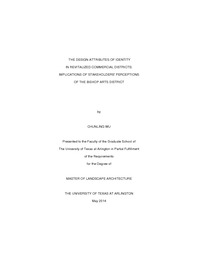
ATTENTION: The works hosted here are being migrated to a new repository that will consolidate resources, improve discoverability, and better show UTA's research impact on the global community. We will update authors as the migration progresses. Please see MavMatrix for more information.
Show simple item record
| dc.contributor.author | Wu, Chunling | en_US |
| dc.date.accessioned | 2014-07-14T20:28:26Z | |
| dc.date.available | 2014-07-14T20:28:26Z | |
| dc.date.issued | 2014-07-14 | |
| dc.date.submitted | January 2014 | en_US |
| dc.identifier.other | DISS-12657 | en_US |
| dc.identifier.uri | http://hdl.handle.net/10106/24459 | |
| dc.description.abstract | This thesis uses qualitative research methods to study the design attributes of identity in revitalized neighborhood commercial districts. Using the Bishop Arts District as a case study, the thesis analyzes the perceptions of stakeholders and the researcher's on-site observations to understand how design attributes reinforce the identity of these districts.Neighborhood commercial district revitalization is one type of urban revitalization. Its goal is to introduce a commercial shopping district into a former industrial or retail area within a historic neighborhood, where a "sense of place" can be produced and consumed (Chang, 2011, p.5). This approach became popular because it would not only preserve the historic features of the districts, but also emphasize the identity by reinforcing the design attributes which carry historical and cultural value. The neighborhood of Bishop Arts was chosen based on the district's revitalization approach of "coexistence of original residents and creative industry practitioners" (Sun, 2010, i). This research investigates design attributes through field observation in the Bishop Art District. Visual design factors are studied and recorded in photographs which address district scale, perception of space, architecture, symbols, materials, and other static and dynamic factors. Additionally, in-depth interviews with visitors and owners are set up to provide knowledge of the individual's experience and opinions. The data are then refined and evaluated to determine the contribution of the attributes.Data comparisons and findings from the neighborhood define a series of design attributes which contribute to the identity of this particular historic neighborhood commercial revitalization. Findings and interview results also suggest that a visual catalog of design attributes can be employed for future revitalization projects that would address neighborhood scale to design details. | en_US |
| dc.description.sponsorship | Richards, James P. | en_US |
| dc.language.iso | en | en_US |
| dc.publisher | Landscape Architecture | en_US |
| dc.title | The Design Attributes Of Identity In Revitalized Commercial Districts: Implications Of Stakeholders' Perceptions Of The Bishop Arts District | en_US |
| dc.type | M.L.A. | en_US |
| dc.contributor.committeeChair | Richards, James P. | en_US |
| dc.degree.department | Landscape Architecture | en_US |
| dc.degree.discipline | Landscape Architecture | en_US |
| dc.degree.grantor | University of Texas at Arlington | en_US |
| dc.degree.level | masters | en_US |
| dc.degree.name | M.L.A. | en_US |
Files in this item
- Name:
- Wu_uta_2502M_12657.pdf
- Size:
- 5.753Mb
- Format:
- PDF
This item appears in the following Collection(s)
Show simple item record


